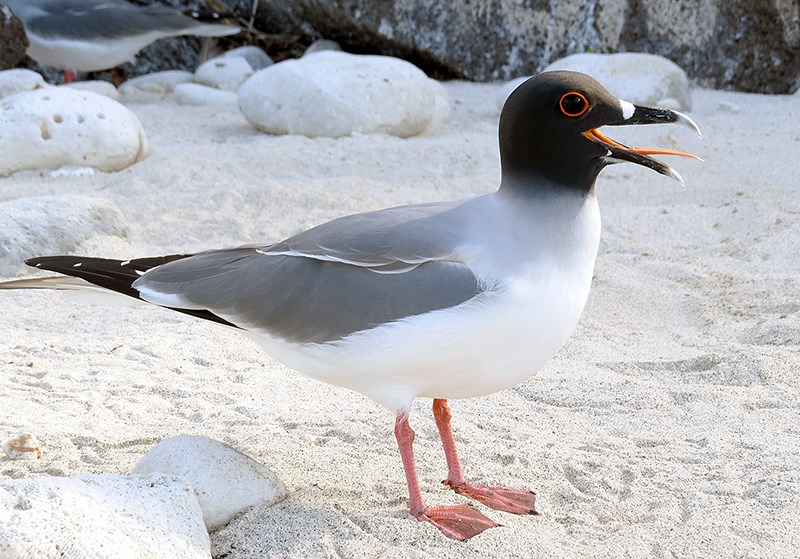Gulls, the ubiquitous scavengers that poke and prod their way along our shorelines, attract little attention from most people.
More often than not, they are misnamed as seagulls. In fact, there is no such thing as a seagull — only gulls of various species, of which 17 are found in B.C.
Identifying particular species is a daunting challenge for novice birders as gull plumage changes seasonally as well as each year until they reach maturity in two to five years.
The tendency of some of these closely-related gull species to produce hybrids only adds to the challenge. Nor are gulls only found in seashore habitats. The bird checklist for the Saskatoon area in inland Saskatchewan lists 14 species of gulls, seven of which are also present in Port Moody. Gulls, it seems, can be found wherever there are enticing food-filled shorelines to attract them.
I must admit that gulls have tended to garner little of the time I spend peering through binoculars — until I travelled to the Galapagos and encountered a most unusual type of gull.
While the swallow-tailed gull of the Galapagos looks like a gull, it is certainly the most elegant one I have ever seen. With red-ringed eyes and mouth plus bright orange feet, it has unusual coloration.
But that is only the beginning of its unique traits. Like many of the species found in the Galapagos, it is considered to be an endemic species found nowhere else. In the case of the swallow-tailed gull, this is not absolutely true as a few pairs are now known to breed on a remote volcanic island off the west coast of Colombia. While this island is not exactly a stone’s throw from the Galapagos, it is in the same general area of the Pacific Ocean.
All of the birds found in the Galapagos must have arrived from elsewhere as these volcanic islands slowly emerged from the Pacific Ocean over millions of years. For example, the Galapagos hawk is considered to be a possible distant relative of the Swainson’s hawk, which migrates from South America to North America every year. The four species of mockingbirds on these islands may have evolved from a single pair of long-tailed mockingbirds that are found along the west coast of Ecuador, a thousand kilometres from the Galapagos.
Some birds appear to be more recent arrivals. For example, both the short-eared and barn owls found in the Galapagos are considered to be endemic sub-species; i.e., they have not yet evolved into distinct species but are on their way to doing so — just give them another few thousand years or so. In contrast, the swallow-tailed gull has no close relatives. It is the sole member of a unique genus of gulls. Where they came from is certainly a mystery.
Their uniqueness lies not only in their genetics but also in their habits. With night-vision, they are the only nocturnal gull in the world. They are not shoreline scavengers but, rather, feed hundreds of kilometres off-shore in the open ocean. Also unlike most other gulls, they lay only one egg and make a unique clicking sound. Some biologists speculate this sound may help them to locate their prey on dark nights. They feed mostly on squid but will catch fish when abundant. They are thought to do this not by diving (which would be most ungull-like) but by lunging forward in the water.
There is, in fact, a great advantage to feeding on the open ocean only at night. Of all the biomass in the ocean, only 2% consists of larger animals. The remaining 98% is made up of plankton — tiny organisms such as diatoms and other phytoplankton — plus small animals such as copepods, crustaceans and gelatinous animals such as jellyfish and salps.
Because phytoplankton require energy from the sun for photosynthesis, they spend the daytime close to the ocean surface but drop to deeper depths at night. Most of the small animals that make up the zooplankton do just the opposite. To escape the attention of predators, they spend the daytime in low light at greater depths but move to the surface every night to feed. This daily diurnal migration helps to move carbon to lower depths of the ocean, where it can be sequestered for long periods of time so it is an important biological mechanism to control global warming.
It also makes feeding during hours of darkness especially productive for animals that eat squid and small fish. The advantages of such night feeding would seem to be reason these swallow-tailed gulls developed this unique trait among gulls.
Viewing these beautiful gulls on their simple nests in ledges carved by waves and sand out of lava in the Galapagos gave me a new appreciation for the gull family. Perhaps I should now tackle the tricky task of trying to identify all gull species closer to home — or maybe not.
--Elaine Golds is a Port Moody environmentalist who is conservation/education chair of the Burke Mountain Naturalists and member of the boards of the Colony Farm Park Association and the Port Moody Ecological Society.



